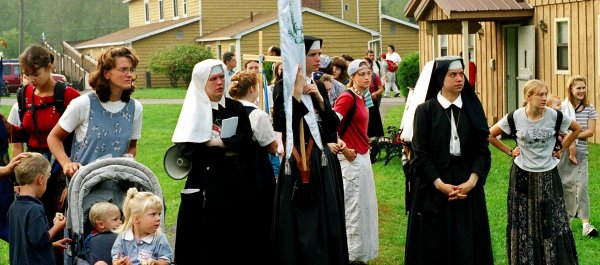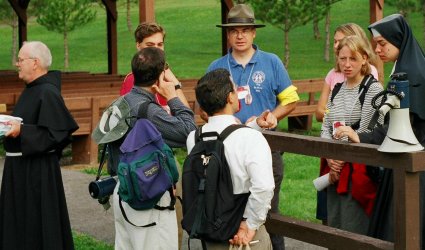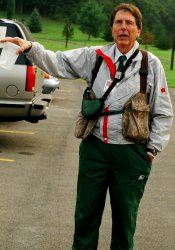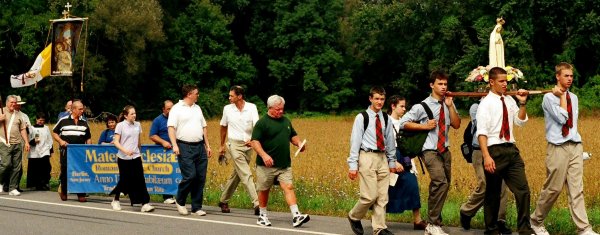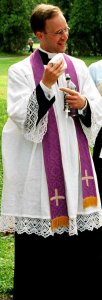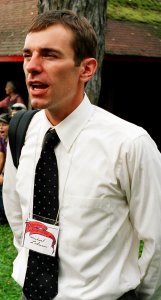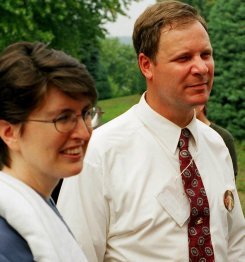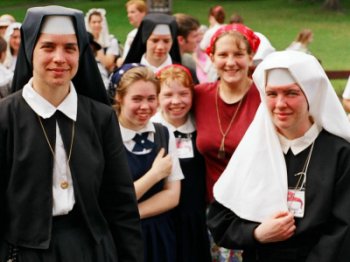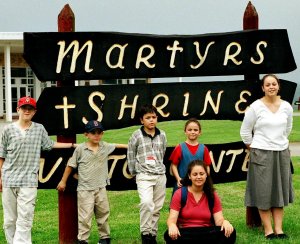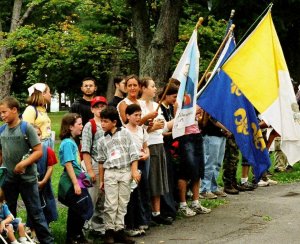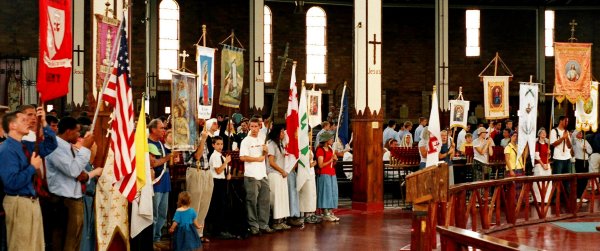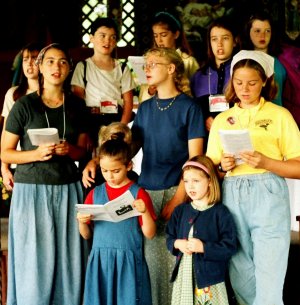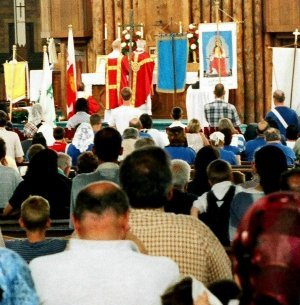

A Traditional Pilgrimage Right Here in America
by John Galvin
|
Many of our readers are aware of the famous Pilgrimage for Tradition from Paris to Chartres, France. This massive international event brings together traditional Catholics from around the world to march and pray and sing and offer up their sufferings in a spirit of reparation. By practicing this traditional Catholic devotion and by offering the traditional Latin Mass each day, the Catholics who come to Chartres are helping to restore the Body of Christ which has suffered grievously in recent years. Most Catholics are likewise familiar with the famous historical pilgrimages such as the one immortalized by Chaucer to visit the shrine of St. Thomas a Becket in Canterbury, and the pilgrimage from Roncevalles to Santiago de Compostela which has been going on continuously since the 11th century.
But how many are aware that right here in America we have our own traditional pilgrimage? Unlike the pilgrimages to Canterbury and Santiago, our tradition is only 8 years old, rather than 8 centuries, but the spirit is just as strong. Traditional Catholics gather from all over the United States to march, to pray, to sing, to participate in the traditional Latin Mass, and to offer their sufferings in reparation for their own sins and the sins of others. The Pilgrimage for Restoration that occurs each September in upstate New York has been attracting new participants for the past 8 years, but it really needs the commitment of all traditional Catholics in North America if we are to make it into an event that rivals Chartres.
Overcoming Isolation
The small numbers of traditional Catholics in many areas of the country means that many Catholics can come to feel lonely and isolated. While the pilgrimage to Chartres offers an opportunity for traditional Catholics from around the world to unite in a common effort, the Pilgrimage for Restoration offers the same opportunity to Catholics in the US and Canada, without requiring the expense of airplane tickets and so forth. Many pilgrims come from the Northeast, a great number come from the NY/PA/NJ area, Wisconsin may well be the state with the largest contingent, and other pilgrims come from all points of the compass.
Families, single adults and youngsters all share an opportunity to spend time with like-minded Catholics. Some relatively well-known names among traditional Catholics participate each year. Even more than my wife and I, my teenage children were tremendously pleased with the opportunity to join together with others their age who shared their devotion to the traditional practices of the Catholic Church. Pen-pal relationships are established that last until the following pilgrimage.
Most importantly, they are not gathering together for the "Party for Restoration" or the "Rock Concert for Restoration." Instead, all are united in a common purpose to participate in a pilgrimage with clearly defined goals, on both a practical and a supernatural level.
|
|
The Latin Mass
The first goal is to deepen and improve one's spiritual and devotional life. This is accomplished through a combination of the sacraments, prayer, directed meditations, and the march itself. Throughout the 4 days of the pilgrimage, the goal remains always before you: to become a better Catholic by offering up all your sufferings on behalf of your individual intentions and the group intentions. This year's intention: "Restoration of True Devotion to Mary, Queen of Peace & of the Holy Rosary."
The traditional Latin Mass is offered early (very early) each morning. Despite the primitive conditions at the campsite, miraculously the picnic pavilion is turned into an altar that is more dignified and worthy than many found in today's church buildings. The pilgrims gather from their tents in the pre-dawn light, some making efforts to work out the aches and pains of yesterday's marching, as mist swirls and a feeling of peace and serenity pervades the area. All kneel on the grass or on the concrete floor of the pavilion, as the beautiful timeless words are intoned by the young yet manifestly devoted priests (one each from the Fraternal Society of Saint Peter and the Institute of Christ the King).
One must admire not only the spiritual ardor of the priests who serve on the pilgrimage, one must also admire their physical stamina and courage. They march every step of the way alongside the other pilgrims, but unlike the pilgrims who might be wearing hiking clothes, they are wearing cassock, surplice and confessional stole. They are required continuously to speed up or slow down their walking in order to march in between brigades so they can hear confessions and offer spiritual direction. This means that between marching with everyone else and moving back and forth in order to offer their spiritual services, they practically do the entire pilgrimage twice. True soldiers of Christ!
|
|
|
Practical Organization
The first morning begins with Mass offered beneath the impressive statue of St. Isaac Jogues that towers over the shore of Lake George (formerly Lake of the Blessed Sacrament). Then after a quick breakfast the pilgrims set out, not to look back until they have covered a significant chunk of the rolling New York countryside. Some of the country does more than "roll," it goes straight up into significant peaks. Three large-size hills are crossed along the way, 1 on the first day and 2 on the second.
The pilgrims are divided up into "brigades" of roughly 20 members. Some brigades are pre-organized from groups that send a substantial number to the pilgrimage, others are formed from pilgrims who share common interests (e.g. the Holy Family Brigade made up of families marching together), while other brigades are formed on the spot. A brigade leader directs the singing and prayer (especially the rosary of which all 15 decades are recited during the course of each day's marching), while safety guards keep an eye on traffic and upcoming intersections.
Each brigade develops its own esprit de corps. Special banners are carried along to identify the brigade and to lead the way forward in the spirit of the Church Militant. As the pilgrimage makes its way along the roads and trails, it presents a very public, visible and unabashed witness of Faith, commitment and dedication to Catholic Tradition in America.
One marches more or less all day. The pilgrimage leaves the campsite between 7:00 and 8:00 AM, having already completed Mass, breakfast and cleanup. And except for an hour break at lunch, the pilgrims are marching all day until they arrive at the next campsite around 6:00PM. An effort is made to keep a continuous pace whether going uphill, downhill, or across level ground, and everyone must stay together with the group.
Along the way, a special group of pilgrims called the Company of St. René Goupil provides support consisting of bottled water, first aid, port-a-potties, and transportation for those who feel they can't march another step. The Company consists of many dedicated volunteers who freely provide their time and effort and vehicles to support the pilgrims and to make sure that the pilgrimage is not marred by accidents or injuries.
The 3 days of solid marching terminate on Friday evening at the shrine of Blessed Kateri Tekawitha in Fonda, NY. A quick service of thanksgiving is held that evening, then the 4th and final day (Saturday) finds several hundred additional pilgrims join for the final 7-mile march from the Tekawitha Shrine to the Shrine of the North American Martyrs in Auriesville, NY. This is built over the very spot where St. Isaac Jogues and his companions were martyred by the Indians whom they were serving. If one were to search North America for the most appropriate location for a pilgrimage destination, it would seem impossible to imagine one more appropriate than this final resting place of several "holy blissful martyrs" who gave their lives to blaze a trail for Catholicism in our land. The shrine is set in a lovely hilltop location with a large church in the round containing several altars, some of which are still oriented for Latin Mass. Here the grand finale Mass concludes the pilgrimage.
|
Physical Hardship
Performing either the entire pilgrimage or a good portion of it entails physical hardship. There are few of any age who are in such good shape that a 25-mile hike with backpack will not exhaust them. Then one sleeps in a tent and does it again the next day, and then again the next. Then on the fourth day a hike of only 7 miles seems like relaxation. Blisters are virtually unavoidable, despite the best efforts of the volunteer nurses to keep them covered with band-aids and "moleskin."
The food is sufficient but spartan. Hot water and bread and jam are supplied each morning. Pilgrims are encouraged to provide their own instant oatmeal, coffee, tea, etc. Each pilgrim packs their own sack lunch, then a dinner of soup and rolls is supplied by the pilgrimage at the end of the day. No one need go hungry, and surprisingly the physical labor acts more as an appetite suppressant than otherwise, but it's certainly not 4-star dining.
All pilgrims share the campgrounds, sleeping in tents on Wednesday and Thursday nights. The pilgrimage will transport to the next campsite a sleeping tent and a backpack for each pilgrim. Families participating together (e.g. Dad and older kids march, while Mom and younger kids participate in the modified pilgrimage) can bring larger tents and transport their own equipment to the next campsite. No common facilities are provided for Tuesday or Friday evenings, but the NCCL website offers suggestions for convenient places to stay or to camp.
|
Suffering
Sometimes there might be a tendency to skip lightly over the physical aspects of an event like this and say something like, "Yes there was some pain and suffering, but it was all worth it." No matter how true it may be that it was worth it, to skip lightly over the suffering would be to misrepresent the purpose and the reality of the pilgrimage. Yes, there is physical hardship, and when you are in the midst of the march, it will be about the only thing you'll be capable of thinking: how much everything hurts. Yet this is not accidental or something to be avoided at all cost - this is the reason why we're here.
First and foremost the pilgrimage is an opportunity to practice mortification. In terms of the other goals mentioned above, how does one deepen his spiritual life, develop humility and charity, eliminate tendencies to sin, and create opportunities for making reparation for our own sins and the sins of others? Only through mortification. Love requires suffering. Our culture is so firmly opposed to all suffering of any sort, that it requires a special effort to develop a spirit of mortification. The Pilgrimage for Restoration is the ideal way to begin developing that spirit. One has plenty to suffer, and one is in an environment that constantly reminds you to offer all your sufferings in union with the passion of Christ on the Cross.
|
Family Participation
The scheduled time in late September makes the pilgrimage most convenient for home-school families, although others should consider making the effort to participate as well. A large percentage of the participants are members of families that range across the age spectrum from infants to post-college young adults.
Children that are 12 and over may be able to do all or parts of the 70-mile march and participate the same as any adult, although even older children may find they are unable to complete the entire pilgrimage. For those under age 12, mothers of younger children, and any others who feel unable to march the whole way, the Modified Pilgrimage offers a mix of some limited hiking each day, some other spiritual activities aimed at their age level, participation in the morning Mass and the evening services, and some assisting the CSRG with packing tents, clearing the campsite, etc.
|
|
Registration
Please refer to the website of the National Coalition of Clergy and Laity for further information. There you will also find important disclaimers regarding liability, medical insurance, etc. This article is intended for information purpose only, it is NOT published by the NCCL, and it is neither a definitive statement of the purposes of the pilgrimage, nor a legal commitment. The official website will have all the information that is not included here.
Time is running short, the pilgrimage is only a month away, REGISTER NOW. It's already getting late to make plans. But for those who can make it, it will be the experience of a lifetime for your family, a wonderful (and inexpensive) vacation that will make a huge impact in the spiritual life of your family, and a chance to participate more directly in the 4 purposes of Catholic worship: Adoration, Reparation, Thanksgiving and Supplication. You can't say that about a trip to Disney World, now can you?
with the
Company of St. René Goupil
528 North New Street, Suite 2 Bethlehem PA 18018 USA
Tel 610/882-3124 ** 610/882-3125 Fax
Coalition@fast.net
|
Links:
http://www.national-coalition.org/pilgrim/index.html
http://www.national-coalition.org/pilgrim/registration.html


